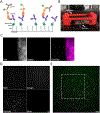An Optimized Single-Molecule Pull-Down Assay for Quantification of Protein Phosphorylation
- PMID: 35723488
- PMCID: PMC9317552
- DOI: 10.3791/63665
An Optimized Single-Molecule Pull-Down Assay for Quantification of Protein Phosphorylation
Abstract
Phosphorylation is a necessary posttranslational modification that regulates protein function and directs cell signaling outcomes. Current methods to measure protein phosphorylation cannot preserve the heterogeneity in phosphorylation across individual proteins. The single-molecule pull-down (SiMPull) assay was developed to investigate the composition of macromolecular complexes via immunoprecipitation of proteins on a glass coverslip followed by single-molecule imaging. The current technique is an adaptation of SiMPull that provides robust quantification of the phosphorylation state of full-length membrane receptors at the single-molecule level. Imaging thousands of individual receptors in this way allows for quantifying protein phosphorylation patterns. The present protocol details the optimized SiMPull procedure, from sample preparation to imaging. Optimization of glass preparation and antibody fixation protocols further enhances data quality. The current protocol provides code for the single-molecule data analysis that calculates the fraction of receptors phosphorylated within a sample. While this work focuses on phosphorylation of the epidermal growth factor receptor (EGFR), the protocol can be generalized to other membrane receptors and cytosolic signaling molecules.
Figures



References
-
- Gibson Scott K., Parkes John H., and & Liebman PA Phosphorylation Modulates the Affinity of Light-Activated Rhodopsin for G Protein and Arrestin. Biochemistry 39(19), 5738–5749 (2000). - PubMed
Publication types
MeSH terms
Grants and funding
LinkOut - more resources
Full Text Sources
Research Materials
Miscellaneous
